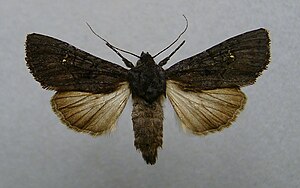Black smooth-backed owl
| Black smooth-backed owl | ||||||||||||
|---|---|---|---|---|---|---|---|---|---|---|---|---|

Black backed owl ( Aporophyla nigra ) |
||||||||||||
| Systematics | ||||||||||||
|
||||||||||||
| Scientific name | ||||||||||||
| Aporophyla nigra | ||||||||||||
| ( Haworth , 1809) |
The aporophyla nigra ( Aporophyla nigra ) is a butterfly ( moth ) from the family of cutworms (Noctuidae).
features
butterfly
The wingspan of the moth is 40 to 48 millimeters. The color of the forewings is usually shiny dark black-brown. There are also animals that are almost pure black, but also those that shimmer red-brown. Kidney, tenon and ring flaws hardly stand out from the ground. Only in the area of the kidney defects can yellow dots sometimes be seen. The hind wings of the females are gray, those of the males are almost pure white, whereby the veins stand out clearly.
Egg, caterpillar, pupa
The whitish egg has a hemispherical shape and is clearly ribbed.
Brownish, reddish and greenish specimens appear in the caterpillars . Accordingly, they also have differently colored, darkened back lines, as well as whitish or yellowish side stripes and white, black-edged stigmas .
The brown doll is missing thorns or tips on the cremaster .
Similar species
In Tunisia the lighter colored subspecies Aporophyla nigra cinerea flies , which in some ways resembles the specimens of Aporophyla australis and Trigonophora haasi . The moths of the latter two species are, however, somewhat paler in color.
distribution and habitat
The distribution of the species extends from North Africa through southern and central Europe to Asia Minor, in the north to Scotland and southern Norway . It is also found in the Caucasus , Israel and Lebanon . The animals are mainly to be found in dry areas, for example on semi-arid lawns and gorse heaths, on sunny embankments or in vineyards.
Way of life
The nocturnal moths live mostly in September and October, but can still be found in December or January. They visit artificial light sources as well as laid baits . Their caterpillars feed on various plants, for example sweet grasses (Poaceae), clover ( Trifolium ), dock ( Rumex ), small meadow button ( Sanguisorba minor ) as well as gorse species ( Genista ) and others. The species overwinters in the caterpillar stage.
Danger
The black smooth-backed owl is rare in most of its range in Germany. It is classified in Category 2 (critically endangered) on the Red List of Endangered Species .
swell
Individual evidence
- ↑ a b Lázló Ronkay, José Luis Yela & Márton Hreblay: Hadeninae II . In: Michael Fibiger, Martin Honey (Ed.): Noctuidae Europaeae . tape 5 . Entomological Press, Sorø 2001, ISBN 87-89430-06-9 (English).
- ↑ Walter Forster , Theodor A. Wohlfahrt : The butterflies of Central Europe. Volume 4: Owls. (Noctuidae). Franckh'sche Verlagshandlung, Stuttgart 1971, ISBN 3-440-03752-5 .
- ↑ a b Günter Ebert (Ed.): The butterflies of Baden-Württemberg . 1st edition. tape 6 . Moth IV. Noctuidae 2nd part. Ulmer, Stuttgart (Hohenheim) 1997, ISBN 3-8001-3482-9 .
- ↑ Federal Agency for Nature Conservation (Ed.): Red List of Endangered Animals in Germany . Landwirtschaftsverlag, Münster 1998, ISBN 3-89624-110-9 .
literature
- Günter Ebert (Ed.): The butterflies of Baden-Württemberg . 1st edition. tape 6 . Moth IV. Noctuidae 2nd part. Ulmer, Stuttgart (Hohenheim) 1997, ISBN 3-8001-3482-9 .
- Lázló Ronkay, José Luis Yela & Márton Hreblay: Hadeninae II . In: Michael Fibiger, Martin Honey (Ed.): Noctuidae Europaeae . tape 5 . Entomological Press, Sorø 2001, ISBN 87-89430-06-9 (English).
Web links
- Lepiforum eV photos
- www.schmetterlinge-deutschlands.de Endangerment
- Aporophyla nigra at Fauna Europaea